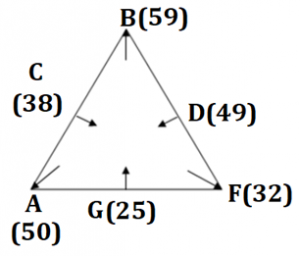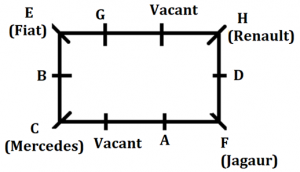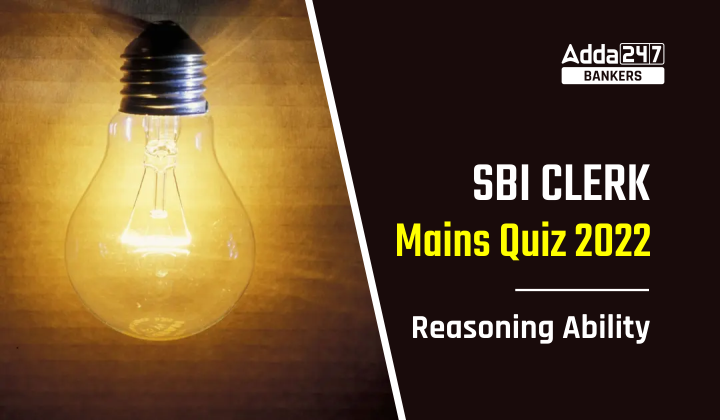Direction (1-5): Study the following information carefully and answer the questions accordingly.
Six people are sitting around a triangle table. Three of them sit at the corners facing outside and three are sitting on the sides facing inside. Each one of them has a different number of balls ranging 17 – 80.
G has 7 balls less than F who has 27 less balls than B. D has the balls of perfect square number but not a neighbor of G. The one who has 50 balls, is not facing inside. The one who sits immediate right of C is having more than 26 balls. The difference between the numbers of balls the neighbors of A having is 13. B sits three places away from the one who has 25 balls. The difference between the number of balls D and C having is a multiple of 11. F sits two places away from the one who has 50 balls. The difference between the number of Balls C and A having is 12. C sits second to the right of the one who has more than 40 balls. One person sits between B and A who sits immediate right of the one who has even numbered balls.
Q1. Who among the following sits near the one who has 59 balls?
(a) A
(b) G
(c) D
(d) F
(e) None of these
Q2. How many balls F has?
(a) 25
(b) 51
(c) 45
(d) 32
(e) None of these
Q3. Who among the following has the maximum number of balls?
(a) D
(b) B
(c) C
(d) A
(e) None of these
Q4. What are the total number of balls A and G has?
(a) 109
(b) 93
(c) 82
(d) 75
(e) None of these
Q5. Four of the following five are alike in a certain way and hence form a group as per the given arrangement. Which of the following does not belong to that group?
(a) G – F
(b) F – D
(c) D – B
(d) B – C
(e) C – G
Directions (6-10): Answer the questions based on the information given below.
Eight persons A, B, C, D, E, F, G and H attend a dinner party. They sit around a rectangular table such that there are two seats on each of the longer side of the table, one seat on each of the shorter side of the table and one seat on each of the corner of the table. The distance between two adjacent seats is equal. Only the persons who sit on the corner seats, own car of different brand, Fiat, Renault, Jaguar and Mercedes. Also, only two seats are vacant. All the persons face towards the centre.
Note: If a person is first/second/third person to the left/right of another person, then there may or may not be a vacant seat in between them.
D who does not own a car is second person to the right of A. A sits along one of the longer side of the table. The person who owns Fiat sits on the first seat to the right of G’s seat. G does not sit on the seat opposite to D’s seat. The first seat to the right of H’s seat is vacant. H does not own Fiat or Mercedes. C is the first person to the right of Buck who does not own a car. The person who owns Mercedes, is second person to the right of E. F’s seat is not adjacent to any of the vacant seats. The person who is second person to the right of C does not own Renault.
Q6. After the party, if the persons, who do not own car, left the party with the person, who is immediate right to them, then which of the following pair of persons left the party together?
(a) C, B
(b) G, A
(c) H, D
(d) C, G
(e) More than one combination is correct
Q7. Seat of the person who owns Renault is fourth to the left of which of the following person?
(a) F
(b) C
(c) A
(d) B
(e) None of these
Q8. Who among the following owns Fiat car?
(a) E
(b) C
(c) F
(d) G
(e) None of these
Q9. Which of the following statement is/are not true?
(a) D’s seat is fourth to the right of the one who own Mercedes
(b) C and A sit adjacent to vacant sit
(c) A is facing G
(d) Both (a) and (b)
(e) All are correct
Q10. Four of the following five are alike in a certain way and hence form a group as per the given arrangement. Who among the following does not belong to that group?
(a) A
(b) G
(c) B
(d) D
(e) E
Directions (11-15): Answer the questions based on the information given below.
Eight buildings B, C, D, E, F, G, H and l are built in a straight line facing towards north direction. Each building has different number of floors i.e., 3, 5, 6, 9, 16, 18, 20 and 24 but not necessarily in the same order. Each building is painted by different colour among Red, White, Yellow, Green, Blue, Pink, Cyan and Orange.
Note: The dimension of the plot on which each building is built is same.
Sum of the number of floors of B and D is equal to the floors of l. D has more floors than B. D is built at one of the extreme ends of the line and is 2nd to the left of B. H has 2nd highest number of floors and is built 2nd to the right of that building which is painted White which is built adjacent to B. C is built immediate left of H. Building which is painted Yellow is built just left of G which is painted Cyan. Only three building are built between G and F. Only two buildings are built between the building which is painted Red and the one which is painted Pink. Building which is painted Pink is neither built to the left of the building Red nor adjacent to the building which is painted White. Building which is painted Orange is built immediate right of the building, which is painted Green. Sum of number of floors of the building, which is painted Orange and the one which is painted Yellow is less than 15. Sum of number of floors of the building which is painted Blue and G is 10 less than the sum number of floors of the building H and F. Building G has less floors than the building which is painted Blue.
Q11. Which of the following building is painted Blue?
(a) D
(b) G
(c) C
(d) E
(e) None of these
Q12. What is the sum of the floors of the building which are built between I and E?
(a) 68
(b) 65
(c) 63
(d) 70
(e) None of these
Q13. Which of the following statement is/are definitely true?
I. Sum of the floors of building E, G and H is 41.
II. Building E is built immediate right of the building which is painted Pink.
III. Building D is painted by Green colour.
(a) Only I and III
(b) Only II and III
(c) Only I and II
(d) Only III
(e) None of the above
Q14. Which of the following building is painted Yellow?
(a) E
(b) I
(c) F
(d) Either E or I
(e) None of these
Q15. Four of the following five are alike in a certain way and hence form a group as per the given arrangement. Which of the following does not belong to that group?
(a) D – Green
(b) B – Red
(c) F – White
(d) C – Blue
(e) H – Yellow
Solutions
Solution (1-5):
Sol.

S1. Ans. (c)
S2. Ans. (d)
S3. Ans. (b)
S4. Ans. (d)
S5. Ans. (e)
Solution (6-10):
Sol.

S6. Ans. (e)
S7. Ans. (b)
S8. Ans. (a)
S9. Ans. (c)
S10. Ans. (e)
Solution (11-15):
Sol.

S11. Ans. (c)
S12. Ans. (b)
S13. Ans. (d)
S14. Ans. (d)
S15. Ans. (e)





 GA Capsule for SBI Clerk Mains 2025, Dow...
GA Capsule for SBI Clerk Mains 2025, Dow...
 The Hindu Review October 2022: Download ...
The Hindu Review October 2022: Download ...
 ECGC PO Scorecard 2025 Out, Check Marks
ECGC PO Scorecard 2025 Out, Check Marks




